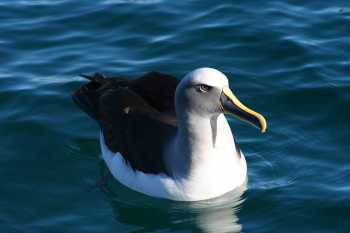Elizabeth (Biz) Bell of Wildlife Management International Ltd has reported to a recent meeting of the Conservation Services Programme Technical Working Group of New Zealand’s Department of Conservation via Project INT2010/02 on the numbers of seabirds reported killed by New Zealand fisheries in 2012/13. Of 431 birds returned from vessels, 342 (79%) were identified as belonging to 11 ACAP-listed species.
The White-chinned Petrel Procellaria aequinoctialis was killed in the most numbers (39% out of the total of 431), followed by White-capped Albatross Thalassarche steadi (21%), Buller’s Albatross T. bulleri (11%) and Salvin’s Albatross T. salvini (5%) among the ACAP-listed species. Of the non-ACAP-listed species the Sooty Shearwater Puffinus griseus was reported killed in relatively large numbers (18% of the overall total).

Buller's Albatross, phootgraph by Chris Golding
The report’s abstract follows:
“New Zealand waters support a diverse range of seabird species, but much of the commercial fishing activity in the region overlaps with their ranges. The accurate identification of seabirds captured in New Zealand fisheries is vital for determining the potential impact of fisheries on these populations. Between 1 July 2012 and 30 June 2013 New Zealand waters a total of 431 seabirds comprising 17 taxa were incidentally killed as bycatch and returned for autopsy by onboard New Zealand Government observers. Birds were returned from longline (n = 30) and trawl (n = 146) vessels, and were dominated numerically by four species (white-chinned petrel Procellaria aequinoctialis, New Zealand white-capped albatross Thalassarche steadi, Buller’s albatross Thalassarche bulleri bulleri and sooty shearwater Puffinus griseus). All birds returned from longline fisheries had injuries consistent with being hooked or entangled in the bill or throat. In contrast, most birds (79.9%) returned from trawl fisheries were killed by entanglement in the net or cod-end, with the remaining 20.1% likely to have been killed by warp interaction. Two birds were killed by striking the deck. Birds had similar mean fat scores as in the previous fishing year, and discards, including offal, appear to continue to be an attractant for many seabirds. Out of 138 records of seabird captures on fishing vessels, photographs were taken of 52 seabirds consisting of 13 eleven taxa. Image quality varied widely, with poor images being particularly common for birds that were alive and seen onboard for short periods. Recommendations are made to improve photo-identifications in the future.”
With thanks to Graham Parker for information
Reference:
Bell, E. [A.] 2013. Identification of Seabirds Captured in New Zealand Fisheries: 1 July 2012 – 30 June 2013. Draft Final Report to Conservation Services Programme Technical Working Group, 21 November 2013. Wellington: Department of Conservation. 44 pp.
John Cooper, ACAP Information Officer, 08 December 2013

 English
English  Français
Français  Español
Español